|
Jan. 25, 2024
Stay informed! Here’s a summary of upcoming wildlife and habitat management activities and ways you can discover, explore and experience Minnesota’s outdoors.

College students can apply for DNR internships by Jan. 31
College students: Experience outdoor adventure through our summer internships!
Don’t miss out on your chance to start your career in natural resources. We have more than 200 summer internships available throughout the state that will give hands-on experience in a variety of roles including wildlife management, waterfowl banding, fisheries management and more. The deadline to apply for a paid summer internship with the DNR is Wednesday, Jan. 31. Do you know someone who would love to join our team? For more information, including how to apply, go to the DNR website.
|
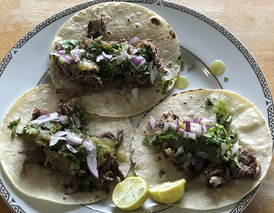
The taste of success
Thank you to everyone who shared venison recipes with us for the Wild Minnesota Recipe Exchange! We had so many great recipes to choose from. We will be featuring recipes in our newsletters, and on our website, social media and other publications.
Recipes can carry special meaning. They’re passed down generations and are central to cultural traditions. And some are special simply because they taste great. Wild game meals give hunters a chance to fully appreciate their harvest, share with friends and family, and connect with nature on a deeper level.
Today’s featured recipe is the Real Deal Venison Barbacoa Tacos shared by Fernando Chapa, who noted that “barbacoa tacos are a traditional dish from Mexico. It’s customary to eat it on Sunday mornings with the family.”
Find this recipe and other featured recipes on the Minnesota DNR website, and watch for more chances to share recipes in the future.
|
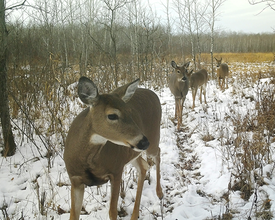
Deer harvest totals and end-of-season questions for you
Looking back at the 2023 deer season, deer harvest totals were significantly lower in northern Minnesota, and close to average in central and southern Minnesota, with 158,746 deer harvested statewide, 8% fewer than last year.
Hunters and anyone interested in deer are invited to share their thoughts in the end-of-season survey. The survey includes questions about experiences hunters had during the deer hunting season, issues related to damage deer might do to crops, landscaping or gardens, and other deer-related issues. The Minnesota DNR will use the feedback to shape regulations for the 2024 hunting season.
|
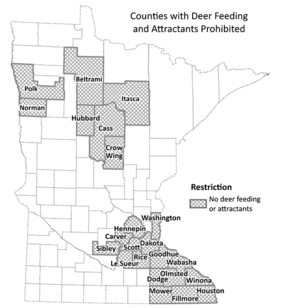
Reminder about the deer feeding ban
Feeding and attractant bans are in place across the state to prevent unnatural concentrations of wild deer in areas with a higher risk for disease. These bans are precautionary steps the Minnesota DNR took after deer that tested positive for chronic wasting disease were found both in the wild and on deer farms. Feeding bans encompass wider areas because food sources can concentrate deer and allow for close contact — one of the mechanisms for CWD spread. Please find more details including which counties are included in these bans, on the Minnesota DNR website.
|
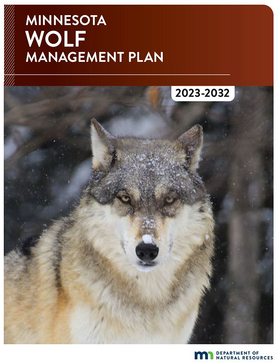
Join these wildlife webinars
Each Wednesday the Minnesota DNR invites people interested in wildlife and outdoor skills to check out Minnesota Outdoor Skills and Stewardship Series webinars. We have a couple coming up you may be interested in — one on wolves in Minnesota and another on winter deer behavior.
On Wednesday, Jan. 31, Dan Stark, DNR large carnivore specialist, will share information on Minnesota’s wolf population, ecology and management along with an overview of the DNR’s updated plan to guide wolf conservation and the challenges of a recovered wolf population.
On Wednesday, Feb. 7, DNR big game specialists will discuss the winter severity index and discuss recent winters and their impacts on deer. They will also cover some adaptations deer have developed that help them to survive winter, and what you could do to help them out, including habitat improvements that can be made on private land. Finally, there will be some discussion on the negative effects of supplemental feeding of deer in winter.
These webinars are free and offered year-round, though registration is required. Visit the Outdoor Skills and Stewardship webpage of the Minnesota DNR website for the registration portal, more information about upcoming webinars and recordings of past webinars.
|
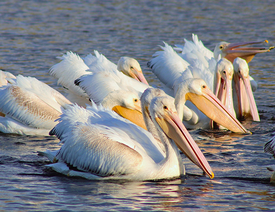
Help improve the Rare Species Guide
We need your help to improve the Rare Species Guide. The guide is a dynamic, interactive resource for information on Minnesota’s endangered, threatened, and special concern species.
Each profile features the status, distribution, ecology, conservation, and management of Minnesota’s rarest animals and plants.
Take the short survey to provide your feedback. You can also check out the current version of the guide on the DNR website.
American white pelicans courtesy of Maren Miller, iNaturalist
|

Wildlife highlight: Long-tailed duck can really dive
Lake Superior may be deep, but this duck is an expert diver. The long-tailed duck can dive as deep as 200 feet to forage.
These ducks breed in the high Arctic, but primarily spend their winters along ocean coasts.
Nearly every year, some long-tailed ducks choose to winter on the North Shore of Lake Superior.
Long-tailed ducks feed on mollusks (mussels and clams), crustaceans, small fish and aquatic invertebrates in the Great Lakes. They will also consume invasive zebra mussels. These ducks are known for their call, which sounds like yodeling or laughter. Some birdwatchers describe the call as the birds saying, “Tom, Tom-Connolly.” Learn more about this beautiful winter migrant.
Photo courtesy of pinemartyn, iNaturalist
|
|